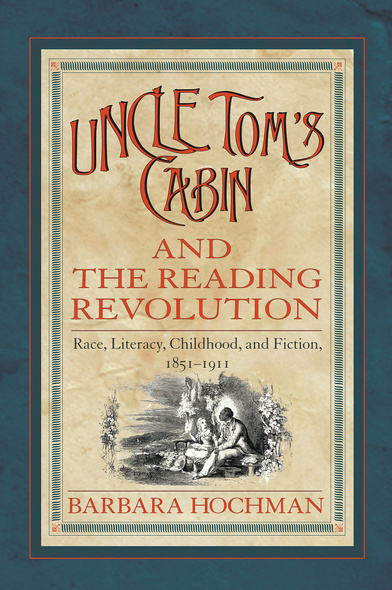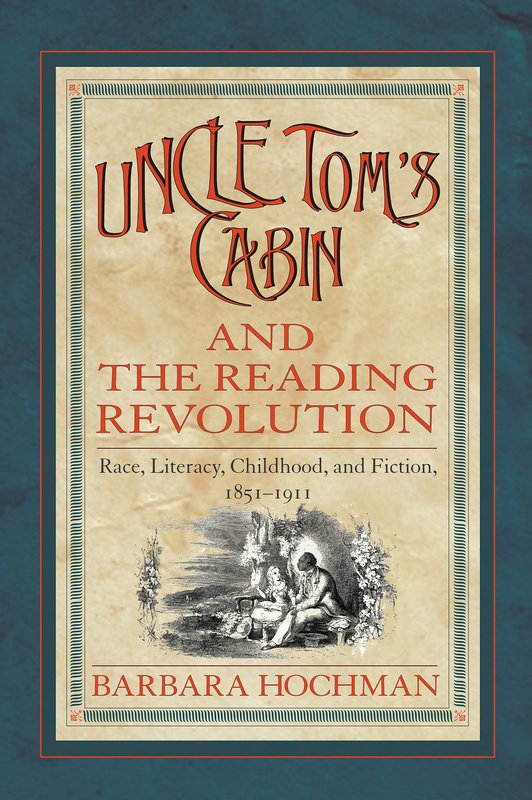"Uncle Tom's Cabin" and the Reading Revolution
Race, Literacy, Childhood, and Fiction, 1851-1911
University of Massachusetts Press
"Uncle Tom's Cabin" and the Reading Revolution explores a transformation in the cultural meaning of Stowe's influential book by addressing changes in reading practices and a shift in widely shared cultural assumptions. These changes reshaped interpretive conventions and generated new meanings for Stowe's text in the wake of the Civil War.
During the 1850s, men, women, and children avidly devoured Stowe's novel. White adults wept and could not put the book down, neglecting work and other obligations to complete it. African Americans both celebrated and denounced the book. By the 1890s, readers understood Uncle Tom's Cabin in new ways. Prefaces and retrospectives celebrated Stowe's novel as a historical event that led directly to emancipation and national unity. Commentaries played down the evangelical and polemical messages of the book.
Illustrations and children's editions projected images of entertaining and devoted servants into an open-ended future. In the course of the 1890s, Uncle Tom's Cabin became both a more viciously racialized book than it had been and a less compelling one. White readers no longer consumed the book at one sitting; Uncle Tom's Cabin was now more widely known than read. However, in the growing silence surrounding slavery at the turn of the century, Stowe's book became an increasingly important source of ideas, facts, and images that the children of ex-slaves and other free-black readers could use to make sense of their position in U.S. culture.
During the 1850s, men, women, and children avidly devoured Stowe's novel. White adults wept and could not put the book down, neglecting work and other obligations to complete it. African Americans both celebrated and denounced the book. By the 1890s, readers understood Uncle Tom's Cabin in new ways. Prefaces and retrospectives celebrated Stowe's novel as a historical event that led directly to emancipation and national unity. Commentaries played down the evangelical and polemical messages of the book.
Illustrations and children's editions projected images of entertaining and devoted servants into an open-ended future. In the course of the 1890s, Uncle Tom's Cabin became both a more viciously racialized book than it had been and a less compelling one. White readers no longer consumed the book at one sitting; Uncle Tom's Cabin was now more widely known than read. However, in the growing silence surrounding slavery at the turn of the century, Stowe's book became an increasingly important source of ideas, facts, and images that the children of ex-slaves and other free-black readers could use to make sense of their position in U.S. culture.
A fine pick for college-level students of American literary history and culture. . . . College-level students analyzing Uncle Tom's Cabin must have this.'—Midwest Book Review
'Always lucidly written, original, and deeply and broadly researched. . . . Anyone who teaches Uncle Tom's Cabin will be grateful for Hochman's contextualization of the variety of possible responses to the text'—Patricia Crain, New York University
'An impressive book. . . . Hochman situates herself very effectively within the current debates surrounding the fields of 'the history of the book' and of reading.'—Christopher Wilson, Boston College
'Using an impressively wide array of resources, [Hochman] documents and analyzes how the meaning of Uncle Tom's Cabin changed--for both adult and child readers, black and white--over the course of time. Clearly and concisely charting the interplay of the text of the novel itself, its societal and print contexts, and readers' responses, this volume will undoubtedly serve as a model for future scholars.'—Choice
'For anyone who loves literature, Hochman's book illuminates the fluidity of attitudes toward seminal fictional work, literacy, and the very act of reading fiction itself.'—Portland Press Herald
'Hochman's strength is in her self-recognized 'eclectic sources' that include published and unpublished reader accounts from whites, blacks, and children; scrapbooks; illustrations; forewords; and reviews. These sources offer new and interesting ways to view the novel and remind historians that Uncle Tom's Cabin functioned as a cultural symbol for decades after the Civil War.'—Journal of American History
'[A] fascinating book . . . .'—H-Net
'One of the major accomplishments of Barbara Hochman's latest work,'Uncle Tom's Cabin' and the Reading Revolution, is that her painstaking visual and textual analysis demonstrates beyond a doubt that the form and meaning of a classic novel change over time, very often though deliberate decisions on the part of publishers, illustrators, and other cultural arbiters. By examining multiple editions of Uncle Tom's Cabin over sixty years of its publishing history, Hochman shows that alterations in format and illustration, abridgements of the novel for children, and historical changes in the social attitudes toward African Americans profoundly changed readers' perceptions about messages of social justice contained in Stowe's novel.'—Kritikon Litterarum
'A thought-provoking, meticulously researched, elegantly written account of the changes in the reception--the transformation in 'the cultural meaning'--of Uncle Tom's Cabin over six decades.'—Journal of American Studies
'By working through the ways Stowe depicts readers and was in turn read by them, Hochman gives us layered insight into the history of reading as well as the history of reading this book.'—Register of Kentucky Historical Society
'...a major contribution to our understanding of reading practices in the nineteenth century—and to the ongoing debate about the place of Stowe's famous novel in American literary history.'—Legacy
'. . . wholly original. . . . this is an excellent study overall, and I hope its approach and methodology will inspire a great number of future scholars to investigate the rich 'afterlives' of other texts.'—Reception: Texts, Readers, Audiences, History
'. . . offers convincing accounts of readers' lived experiences of Stowe's novel.'—Nineteenth-Century Literature
'Early in the book, Hochman argues 'Stowe's novel altered the horizon of expectations for sentimental tales' (31). With a keen eye for analyzing visual culture and paratexts, Hochman has altered expectations for new histories of reading, demonstrating the possibilities for deep study of the range of cultural meanings ascribed to one book and its change over time. In recognition of its scholarly contribution to the history of reading, 'Uncle Tom's Cabin' and the Reading Revolution was the recipient of SHARP's 2012 DeLong Book History Book Prize, and deservedly so. Hochman's study will be of interest to scholars of nineteenth-century U.S. history and literature, and should have a long life in the classroom, where Uncle Tom's Cabin is still required reading for countless undergraduate students.'—SHARP News
'Insightful and engaging. . . . Hochman's book is well researched, thorough, and innovative.'—Resources for American Literary Study
'An epilogue, 'Devouring Uncle Tom's Cabin: black readers between Plessy vs. Ferguson (1896) [which made segregation legal] and Brown vs. Board of Education (1954),' is the author's most important chapter as she tries to explain the unique meaning of Stowe's novel for African Americans as the ongoing repercussions of the Civil War and the failure of Reconstruction were intensified by legalized segregation. . . . It is a pleasure to recommend this well-researched book.'—Journal of American Culture
'In an important epilogue, Hochman reveals that, even if white readers at the turn of the century no longer read Stowe's novel with political and moral urgency, African Americans continued to read it intensely, looking to Stowe's novel for insights into the slavery past as well as their own racial identities in the Jim Crow era. . . . Hochman's account of the cultural transformation of Uncle Tom's Cabin offers a fresh perspective on how the act of reading shapes and is shaped by the culture around it.'—Journal of the History of Childhood and Youth
'Hochman provides brilliant insights as she conducts archival research on black scrapbooks and reading journals and how Uncle Tom's Cabin often was the only source of information about slavery that young black Americans had access to. Reading the novel amounted to a historical lesson for a generation of readers, including James Baldwin, who read it 'obsessively' and 'compulsively,' despite his later famous inflammatory essay against the novel. This final chapter is in overall consonance with Hochman's strategy throughout her book of reading Uncle Tom's Cabin as constituting and participating in a veritable 'reading revolution.''—American Literary Realism
'Hochman's compelling central revelation [is that] reading practices and racial ideologies are not only interconnected, but mutually reinforcing.'—American Literature
'Part of what makes Hochman's study so valuable, especially to historians, is her methodological decision to underscore the history of Uncle Tom's Cabin as both a story (literary text) and an object (book). Instead of emphasizing either the reader's autonomy in deciding textual meaning or the text's independent authority over its meaning, Hochman takes a less deterministic middle-ground position: 'the theoretical and methodological intersection where literature meets history.''—Journal of the Gilded Age and Progressive Era
'Well-grounded in archival research and reader response theory . . . 'Uncle Tom's Cabin' and the Reading Revolution is a rich and rewarding book.'—Amerikastudien
'By focusing on editions for both children and adults, Hochman is able to cover enormous ground and draw powerful conclusions regarding the cultural influence of the novel. . . . 'Uncle Tom's Cabin' and the Reading Revolution will be essential to Stowe scholars, researchers in American children's literature, and enthusiastic general readers alike.'—Bookbird: A Journal of International Children's Literature
Barbara Hochman is professor in the Department of Foreign Literatures and Linguistics at Ben-Gurion University of the Negev, Israel, and author of Getting at the Author: Reimagining Books and Reading in the Age of American Realism (University of Massachusetts Press).





